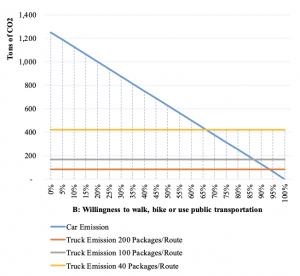Many retailers are making efforts to improve their channel integration to enhance the order fulfillment for their customers. Network optimization is a key element. At the same time, more companies are trying to make their supply chains more sustainable, and transportation evidently accounts for a large share of CO2 emissions.
Nonetheless, the trade-off between cost reduction and CO2 emissions reduction is often difficult to determine, and even harder to see as a tool for a company to make strategic decisions.
MIT researchers focused on an American department store chain with the aim to select the optimal stores as pick-up spots and evaluates the environmental impact of the findings. MIT researchers used more than 10 million records provided by the American department store chain and develop a binary integer linear programming model to estimate potential savings.
MIT researchers performed a sensitivity analysis to analyze the impact of the customer’s decisions in both economic and environmental magnitudes. Results show the significant importance of two variables: the customers’ willingness to travel and pick up their packages, and the customer’s willingness to avoid using a motor vehicle. With this analysis, the researchers provide recommendations for implementing the order-online-and-pick-up-in-store mode in a sustainable and cost-effective way, including educating the customers in using more environmentally friendly transportation modes.
Source: MIT

